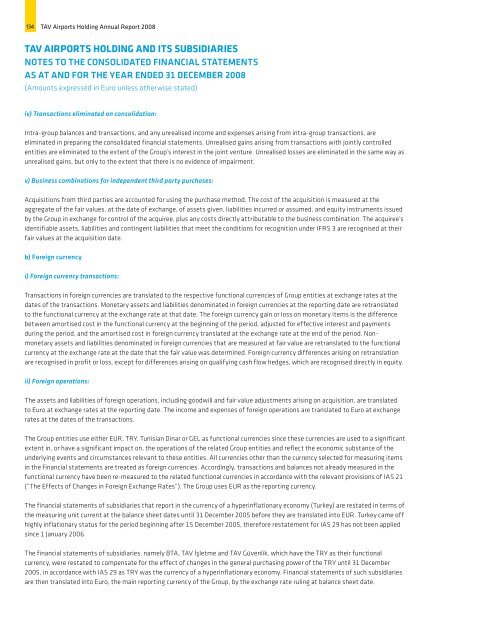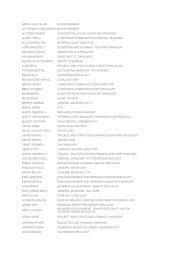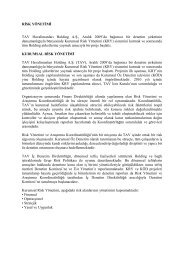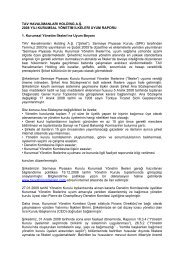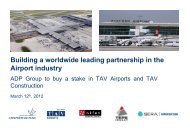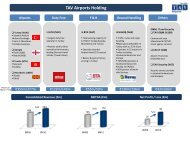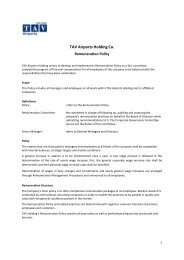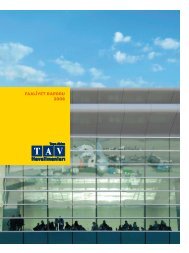TAV IT
TAV IT
TAV IT
You also want an ePaper? Increase the reach of your titles
YUMPU automatically turns print PDFs into web optimized ePapers that Google loves.
134<br />
<strong>TAV</strong> Airports Holding Annual Report 2008<br />
<strong>TAV</strong> AIRPORTS HOLDING AND <strong>IT</strong>S SUBSIDIARIES<br />
NOTES TO THE CONSOLIDATED FINANCIAL STATEMENTS<br />
AS AT AND FOR THE YEAR ENDED 31 DECEMBER 2008<br />
(Amounts expressed in Euro unless otherwise stated)<br />
iv) Transactions eliminated on consolidation:<br />
Intra-group balances and transactions, and any unrealised income and expenses arising from intra-group transactions, are<br />
eliminated in preparing the consolidated financial statements. Unrealised gains arising from transactions with jointly controlled<br />
entities are eliminated to the extent of the Group’s interest in the joint venture. Unrealised losses are eliminated in the same way as<br />
unrealised gains, but only to the extent that there is no evidence of impairment.<br />
v) Business combinations for independent third party purchases:<br />
Acquisitions from third parties are accounted for using the purchase method. The cost of the acquisition is measured at the<br />
aggregate of the fair values, at the date of exchange, of assets given, liabilities incurred or assumed, and equity instruments issued<br />
by the Group in exchange for control of the acquiree, plus any costs directly attributable to the business combination. The acquiree’s<br />
identifiable assets, liabilities and contingent liabilities that meet the conditions for recognition under IFRS 3 are recognised at their<br />
fair values at the acquisition date.<br />
b) Foreign currency<br />
i) Foreign currency transactions:<br />
Transactions in foreign currencies are translated to the respective functional currencies of Group entities at exchange rates at the<br />
dates of the transactions. Monetary assets and liabilities denominated in foreign currencies at the reporting date are retranslated<br />
to the functional currency at the exchange rate at that date. The foreign currency gain or loss on monetary items is the difference<br />
between amortised cost in the functional currency at the beginning of the period, adjusted for effective interest and payments<br />
during the period, and the amortised cost in foreign currency translated at the exchange rate at the end of the period. Nonmonetary<br />
assets and liabilities denominated in foreign currencies that are measured at fair value are retranslated to the functional<br />
currency at the exchange rate at the date that the fair value was determined. Foreign currency differences arising on retranslation<br />
are recognised in profit or loss, except for differences arising on qualifying cash flow hedges, which are recognised directly in equity.<br />
ii) Foreign operations:<br />
The assets and liabilities of foreign operations, including goodwill and fair value adjustments arising on acquisition, are translated<br />
to Euro at exchange rates at the reporting date. The income and expenses of foreign operations are translated to Euro at exchange<br />
rates at the dates of the transactions.<br />
The Group entities use either EUR, TRY, Tunisian Dinar or GEL as functional currencies since these currencies are used to a significant<br />
extent in, or have a significant impact on, the operations of the related Group entities and reflect the economic substance of the<br />
underlying events and circumstances relevant to these entities. All currencies other than the currency selected for measuring items<br />
in the financial statements are treated as foreign currencies. Accordingly, transactions and balances not already measured in the<br />
functional currency have been re-measured to the related functional currencies in accordance with the relevant provisions of IAS 21<br />
(“The Effects of Changes in Foreign Exchange Rates”). The Group uses EUR as the reporting currency.<br />
The financial statements of subsidiaries that report in the currency of a hyperinflationary economy (Turkey) are restated in terms of<br />
the measuring unit current at the balance sheet dates until 31 December 2005 before they are translated into EUR. Turkey came off<br />
highly inflationary status for the period beginning after 15 December 2005, therefore restatement for IAS 29 has not been applied<br />
since 1 January 2006.<br />
The financial statements of subsidiaries, namely BTA, <strong>TAV</strong> İşletme and <strong>TAV</strong> Güvenlik, which have the TRY as their functional<br />
currency, were restated to compensate for the effect of changes in the general purchasing power of the TRY until 31 December<br />
2005, in accordance with IAS 29 as TRY was the currency of a hyperinflationary economy. Financial statements of such subsidiaries<br />
are then translated into Euro, the main reporting currency of the Group, by the exchange rate ruling at balance sheet date.


